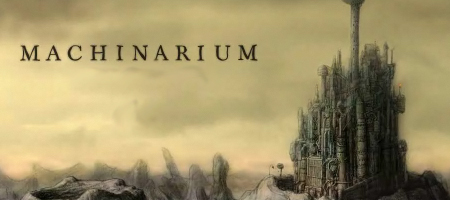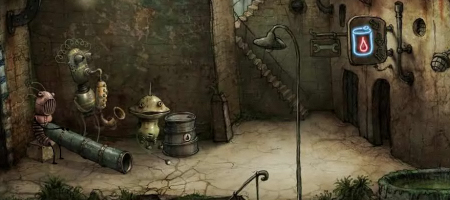Analysing the IGF: Machinarium

It’s been a little while since I did the last of these, but hopefully our recent interview with Amanita Design, makers of Machinarium, was enough to tide you over. Now I’m going to go through my impressions of the game, but this time it’ll be a little different as I’ve not actually played it; everything I’m commenting on here is from videos, screenshots, and things the team have said about the game themselves. That’s not to say there won’t be anything interesting below, but, y’know, just a warning.
The story of Machinarium is the first obviously interesting thing about it; you play an robot cast out of a town full of robots, and then you find out that something is going to destroy the robot town and try to stop it. Simple enough, right? The ways with which you go about this, however, seem to be slightly more complicated, with a few of the puzzles shown in the trailers proving to be logical, but, well, puzzling. Wonderfully, they seem to be embracing the fact that you’re not a human, with possibilities of detaching parts of yourself and extending and compacting your body offering new solutions to the puzzles. Basically, you’re not just manipulating your environment, but yourself, aswell.
The art style of course deserves a mention, as the game has been nominated for the Excellence in Visual Art award at this year’s IGF, and really, it’s beautiful. Very hand drawn, very steampunk, and very compelling. It may be mostly consisting of the browns and greys that have plagued the ‘gritty’ gaming as of late, but here it’s suitable. What need have robots for bright splashes of colour? Sure, there are scenes involving robots playing instruments and the like, but having a monotone city seems like the sort of thing robots would do.

Not only that, but there are some lovely little effects on display in the trailers. The telescope sequence, for one, is particularly excellent, but even something as simple as having multiple planes moving separately as you pan around a scene add depth to the visuals. Machinarium is definitely a game that is going to be pored over slowly, rather than rushed through. But then, that’s what adventure games are for, right? Appreciation and relaxation.
I’m particularly looking forward to Machinarium just because I’m intruiged in the story, and I just love how it looks. After playing a few of the other games by the studio, such as Samarost or Questionaut, it’s hard to think they’ll do anything particularly wrong, so it’s just a matter of waiting for it to come out later in the year, and then spending a suitable amount of time getting lost in it.
Machinarium is nominated for Excellence in Visual Art at this year’s IGF Awards. And here’s the trailer:
Machinarium Preview 02 from Amanita Design on Vimeo.